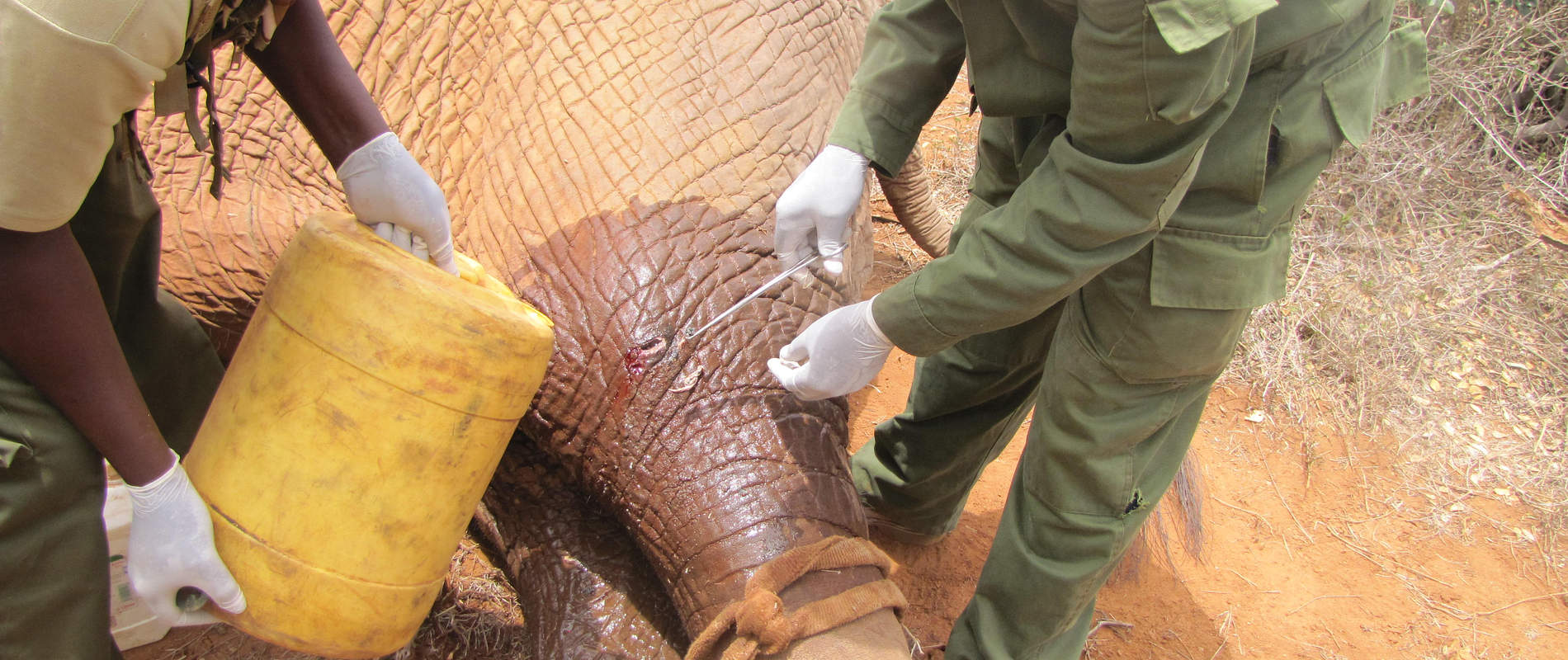FIELD VETERINARY REPORT FOR TSAVO MOBILE VET UNIT FOR THE MONTH OF SEPTEMBER 2015 Reported By Jeremiah Poghon Introduction Tsavo conservation area remained busy with several cases attended, mainly elephants, but also other species including lions and impala
FIELD VETERINARY REPORT FOR TSAVO MOBILE VET UNIT FOR THE MONTH OF SEPTEMBER 2015
Reported By Jeremiah Poghon
Introduction
Tsavo conservation area remained busy with several cases attended, mainly elephants, but also other species including lions and impala. Cases attended included treatment of 2 elephants with fresh arrow wounds in Satao camp area, immobilization and euthanasia of an elephant bull with bullet wound injuried in Ndia Ndasa, de-snaring an impala and water buck, rescue of cheetah cubs and autopsy of poached elephant in Kasigau ranch. Non-medical cases included a rescue of elephant calf from a water dam, immobilization and translocation of a problematic lioness in Amboseli
CASE#1 TREATMENT OF AN ELEPHANT WITH AN ARROW WOUND
Date: 1st September 2015
Species: Elephant
Sex: Male
Age: Adult 40 years
Location: Satao, Tsavo East National Park
GPS coordinates
History
The elephant was seen by patrol aircraft near the Satao area with a fresh arrow wound to the left abdominal wall with blood oozing out. The team rushed to the area to find the lone massive bull moving slowly.


Immobilization, examination and treatment
The elephant was immobilised with 18 mgs of Etorphine in a dan-inject dart from a dan-inject dart gun from a vehicle. It took him 7 minutes to go down on lateral recumbency of the right side.
There was a fresh arrow injury to the left abdominal wall with the arrow still protruding. The arrow head was pulled out and the wound cleaned using water mixed with Hydrogen Peroxide.


Tincture of iodine and Oxytetracycline spray was applied to disinfect the wound. Finally green clay was packed into wound to facilitate healing.

An intravenous administration of 50 cc Dexamethasone Hcl was given through the ear vein and 200 cc of long acting Amoxicillin injected intramuscularly.
Reversal
Drug reversal was done by administration of Diprenorphine Hcl at three times the Etorphine dose. He stood up and walked away calmly.
Prognosis
Good
CASE#2 AUTOPSY OF A POACHED ELEPHANT
Date: 2nd September 2015
Species: Elephant
Sex: Male
Age: Adult
Location: Kasigau ranch, Tsavo east
History
Report was received from the KWS security officers of an elephant carcass found by aerial patrol near Kasigau/Maungu Ranch boundary with the tusks missing. They requested for autopsy to determine the cause of death. The autopsy is to allow for better prosecution in case offenders are arrested.
General Examination
The carcass age was assessed and found to be two days old and a male. The front of the face was chopped off and tusks missing.
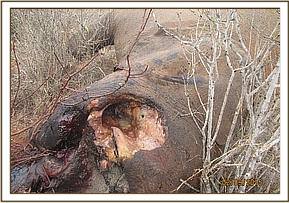
Early stage of autolysis was setting in and the carcass was swollen. Several penetrating wounds were observed to the right side of the chest and scapula area and one penetrating the hacked facial bone into the head. The carcass was opened and massive internal haemorrhage was observed. The puncture wounds affected the lungs, heart and the liver. No bullet head was recovered.
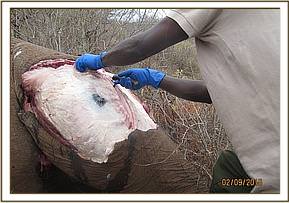
Conclusion
Internal haemorrhage from gunshot wound
CASE#3 TREATMENT OF AN ELEPHANT WITH AN ARROW INJURY
Date: 5th September 2015
Species: Elephant
Sex: Male
Age: Adult
Location: Ithumba, Tsavo East National Park
History
The elephant was seen by the DSWT Ithumba de-snaring team with an injury and lameness while drinking water at the Ithumba watering hole. The vet team was airlifted by the DSWT aircraft for fast response.
Immobilization, examination and treatment
The elephant was immobilised using 18mg Etorphine Hcl in a 1.5 ml Dan - inject dart using a Dan-Inject dart rifle from a helicopter. The helicopter was used to keep the elephant from running into thick bush whilst the drugs took effect. The elephant went down in 12 minutes, lying on the injured side. Ropes were fastened to the front legs and he was rolled over using the vet vehicle.
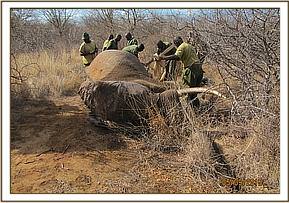
An old wound, probably from a snare, was seen on the left front limb.

The arrow wound was cleaned using Hydrogen peroxide mixed with water then, doused with iodine and covered in green clay.
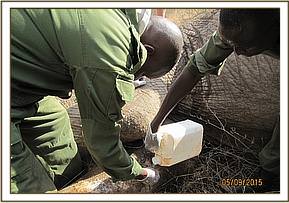

An intravenous administration of Dexamethasone Hcl was given through the ear vein and long acting amoxicillin administered parenterally.
Reversal
Anaesthesia reversal was done by administration of Diprenorphine at three times the Etorphine dose intravenously through the ear vein.
He struggled to wake up and was assisted by ropes hooked on the tusks and the land cruiser. He stood up chased the landcruiser shortly then ran into the bushes.
Prognosis
Good
CASE#4 DESNARING A WATERBUCK
Date: 7th September 2015
Species: Waterbuck
Sex: Male
Age: Adult
Location: Park Hqrs, Tsavo east National Park
History
Several antelopes were seen by KWS staff and tourists with wire snares around their necks and struggling to walk. The vet team visited the site and found one waterbuck and two Impalas with snares around their necks.
Immobilization, examination and treatment
The waterbuck was immobilised using 5mg Etorphine Hcl and 40mg Xylazine in a 1.5 ml Dan - inject dart using a Dan-Inject dart rifle and went down in 5 minutes.
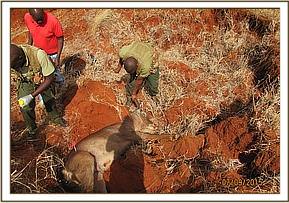
The wire snare was cut loose and luckily it had not caused much damage to the tissues. The wounds were cleaned and long acting antibiotic administered.
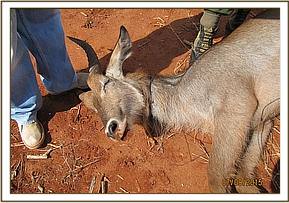

Reversal
Anaesthesia was reversed by administration of Diprenorphine and Atipemazole Hcl intravenously through the jugular vein
Prognosis
Good
CASE#5 DESNARING TWO IMPALA AND TREATING A THIRD
Date: 7th September 2015
Species: Impala x 3
Sex: Female
Age: Adult
Location: Park hqrs, Tsavo East National Park
History
Several antelopes were seen by KWS staff and tourists with wire snares around their necks and struggling to walk. The vet team visited the site and found one waterbuck and two Impalas with snares around their necks.
Immobilization, examination and treatment
Each impala was immobilised using 2mg Etorphine Hcl and 10mg Xylazine in a 1.5 ml Dan - inject dart using a Dan-Inject dart rifle and went down in 5 minutes.
For the two snared impalas the wire snare was cut loose and thankfully there was little damage to the surrounding tissues. The wounds were cleaned and long acting antibiotic administered.


The third Impala was treated for hind limb weakness thought to have been caused by hypovitaminosis.


Reversal
Anaesthesia was reversed by administration of Diprenorphine and Atipemazole Hcl intravenously through the jugular vein.
Prognosis
Good
CASE#6 TRANLOCATION OF A PROBLEMATIC LIONESS
Date: 11th September 2015
Species: Lioness
Sex: Female
Age: Adult
Location: Amboseli
History
A lioness was spotted on the morning of 11th September near a Maasai manyatta by locals attending to a water pump. Because the resident vet was not available, Tsavo vet was airlifted to Amboseli to attend to the emergency as the local community threatened to kill the lioness.
Immobilization and relocation
The lioness was easily located and immobilized using 300 mgs Ketamine and 4 mgs Meditomidine. She took 17 minutes to go down and was then administered 100mgs Ketamine by hand injection. She was loaded onto a truck and translocated into the Park (Makindu area).

Reversal
She was offloaded while very light on anaesthesia and reversed using Atipemazole Hcl. A team kept watch for two more hours to protect her from other lions or buffalo attacks.
CASE#7 EUTHANSIA OF AN ELEPHANT WITH BULLET WOUNDS
Date: 15th September 2015
Species: Elephant
Sex: Male
Age: Adult
Location: Ndia ndasa, Tsavo East National Park
History
Report was received from Ndia ndasa platoon based north of Tsavo east of an injured elephant bull that could hardly walk. A plane was sent down to Voi to pick the vet for fast response. After search the initial bull was spotted with two other bulls under a tree shade.
Immobilization, examination and treatment
The elephant was immobilised using 18mg Etorphine Hcl in a 1.5 ml Dan - inject dart using a Dan-Inject dart rifle from a helicopter. The helicopter was used to keep the other two bulls away whilst the injured bull succumbed to the drugs, which took 8 minutes. . The elephant went down in 12 minutes, lying on the injured side.
The right hind limb was examined and a diagnosis of a complete fracture of the femur bone was made despite the massive swelling of the upper limb muscles. The complete femoral fracture gave it poor prognosis. Three penetrating bullet wounds were also observed to the limb.
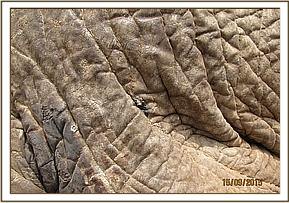
The elephant was euthanized due to poor prognosis and autopsy confirmed the complex and complete femoral fracture from gunshots. The tusks were retrieved and handed to the KWS security team.
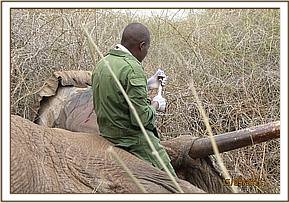

CASE#8 EUTHANSIA OF A PROBLEMATIC LION
Date: 16th September 2015
Species: Lion
Sex: Sub Adult
Age: Adult
Location: Ikanga, Tsavo east National park
History and Management
A lion had left the Tsavo East National Park and started preying on community livestock near Ikanga airstrip. Vet Assistance was sought to immobilize and return it back to the park. The team searched for the lion but were unable to locate it. The following day the Problem Animal Control team (PSC) was called in as a lion had attacked two people and some goats. They had no choice but to put the lion down.
It was brought to the vet clinic for examination on why it was attacking livestock. It was found to be a young male and in poor body condition. He may have been chased out of the pride before perfecting his hunting skills hence looked for easy prey.
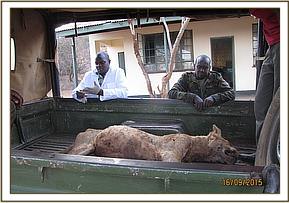

CASE#9 RESCUE OF AN ELEPHANT CALF
Date: 18th September 2015
Species: Elephant
Sex: Unknown
Age: Calf
Location: Pipeline, Tsavo East National Park
Rescue
The temporary water hole was created by leakages along the Mzima-Mombasa water pipeline and subsequently made deeper by elephants digging at the site. It provides water for elephants staying near the park headquarters during the dry season when most of the water holes are dry. Visitors to the area reported an elephant calf was struggling to climb over the walls. The vet team together with the Voi stockade team rushed to the location to find the calf stuck in the water hole and unable to scale the walls with the mother attempting to help.
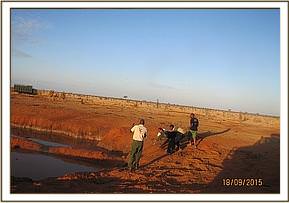

The herd was pushed away and the calf rescued and re united with his family to the great relief of everyone.
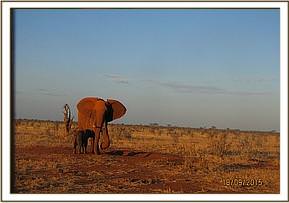
CASE#10 RESCUE OF THREE CHEETAH CUBS
Date: 19th September 2015
Species: Cheetah
Sex: Unknown
Age: Infant
Location: Pipeline, Tsavo East National Park
History and rescue
The Cheetah cubs were stumbled upon by Wildlife works Rukinga staff while putting out a fire caused by suspected poachers hunting for bush meat in the ranch adjacent to Tsavo East National park. The fire burned hundreds of acres of the ranch. An effort to trace the mother for two days was futile. The three cubs were brought into the vet office and fed on formulated infant formula milk for two days and kept in a warm carton box before being airlifted to Nairobi orphanage for better care.
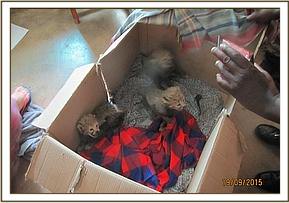

CASE#11 TREATMENT OF AN ELEPHANT WITH AN ARROW WOUND
Date: 20th September 2015
Species: Elephant
Sex: Female
Age: Adult
Location: Satao, Tsavo East National Park
History
Report was received from Satao camp, Tsavo east of an injured elephant cow seen at the water hole with family while drinking water. After a brief search the injured lame cow was spotted near Voi River foraging in a big herd. Drugs were prepared and additional vehicle called in to assist in separating the herd.
Immobilization, examination and treatment
The elephant was immobilised using 16mg Etorphine Hcl in a 1.5 ml Dan - inject dart using a Dan-Inject dart rifle from a vehicle. The Elephant was immobilized after 7 minutes and went down lying on the right flank exposing the wounded side on the upper side. The herd immediately formed a ring cordon around the immobilized elephant. Two vehicles were used to push the herd away but the matriarch fought back and at one point hit the vet unit vehicle damaging it and breaking one tusk in the process. Finally she moved away and the injured elephant was rolled over exposing a fresh arrow wound on the hind limb near the knee joint.
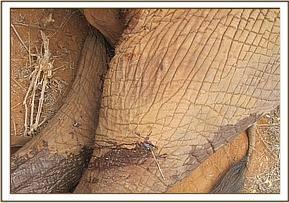
A penetrating arrow was removed and wound cleaned using water mixed with Hydrogen Peroxide.
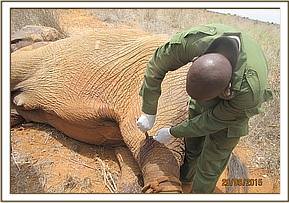

Tincture of Iodine was sprayed on the wound and green clay applied. An intravenous administration of Dexamethasone Hcl and long acting amoxicillin was given through the ear vein.


Reversal
Anaesthesia was reversed by administration of Diprenorphine at three times the Etorphine dose.

Prognosis
Good
CASE#12 AUTOPSY OF A KWS TRACKER DOG
Date: 29th September 2015
Species: Canine
Sex: Female
Age: Adult
Location: Taita ranches, Tsavo East National Park
History and autopsy
This tracker dogs was used by security teams in Tsavo to track poachers in the vast ecosystem and frequently came for medical assistance in the case of illness. After treating another German shepherd dog with mild Hip dysplasia, another dog collapsed while on patrol and was rushed to the vet but arrived dead. Autopsy was carried out and massive hemorrhages were observed in the pericardium, most of the lung lobes and the diaphragm. Most of the other tissues appeared normal.

From the history of long patrols on foot, high temperatures currently experienced in Tsavo, signs before death and autopsy diagnosis of heat stroke was made. Dogs heavily depend on panting for cooling and high environmental temperatures make it difficult to dissipate enough heat from the body.
CASE#13 TREATMENT OF A LAME ELEPHANT
Date: 29th September 2015
Species: Elephant
Sex: Male
Age: Adult
Location: Taita ranches, Tsavo
History
A report was received from KWS Ranch Platoon North, of a lame elephant bull that was seen near Sagana dam while taking water. The team rushed to the area and after brief search the bull was spotted near the water dam.
Immobilization, examination and treatment
The elephant was immobilised using 18mg Etorphine Hcl in a 1.5 ml Dan - inject dart using a Dan-Inject dart rifle from a vehicle. The elephant was immobilized after 8 minutes and went down on sternal recumbency and pushed to lateral recumbency. The left hind leg had no obvious injury despite the signs of lameness and a closer look revealed a deformity on the tarsal joint caused either by a sprain or ligament tear. An intravenous administration of Dexamethasone Hcl was given through the ear vein.


Reversal
The anaesthesia was reversed by administration of Diprenorphine.
Other activities handled by the unit
- The vet attended the Kenya veterinary association (KVA) world Rabies day conference in Malindi.
Acknowledgement
The unit would like to appreciate the support of its sponsors ViER PFOTEN through the David Sheldrick Wildlife Trust (DSWT) for their continued funding. We also thank Kenya Wildlife Service through the Assistant director Tsavo conservation area and the head, veterinary and capture services department for their immense support to the unit.
